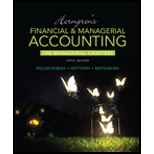
Concept explainers
Match each costing system characteristic to
Used by companies that manufactures identical items through a series of uniform production steps or processes
Match the given statement to job order costing, process costing, or both.
Explanation of Solution
Process Costing: Process costing is method of cost accounting in which all the costs that are incurred production process are recorded. Output of one process becomes input for next process. This method is used to apply cot to similar products that are mass-produced in uninterrupted manner.
Process costing is “Used by companies that manufacture identical items through a series of uniform production steps or processes”.
Want to see more full solutions like this?
Chapter 18 Solutions
Horngren's Financial & Managerial Accounting, The Managerial Chapters (6th Edition)
Additional Business Textbook Solutions
Marketing: An Introduction (13th Edition)
Intermediate Accounting (2nd Edition)
Horngren's Accounting (12th Edition)
Horngren's Cost Accounting: A Managerial Emphasis (16th Edition)
Essentials of MIS (13th Edition)
Operations Management: Processes and Supply Chains (12th Edition) (What's New in Operations Management)
- Over the past four years, the Dow Jones Industrial Average (DJIA) delivered annual returns of 12%, -3%, 18%, and 9%. What is the arithmetic average annual return per year? a) 10.25% b) 8.50% c) 9.00% d) 9.75%arrow_forwardMAX's Auto Repair, a proprietorship, started the year with total assets of $72,000 and total liabilities of $48,500. During the year, the business recorded $120,600 in repair revenues, $65,400 in expenses, and MAX Grant, the owner, withdrew $12,500. MAX’s capital balance at the end of the year?arrow_forwardPeterson Company estimates that overhead costs for the next year will be $3,600,000 for indirect labor and $910,000 for factory utilities. The company uses machine hours as its overhead allocation base. If 110,000 machine hours are planned for this next year, what is the company's plantwide overhead rate? a) $41.00 per machine hour b) $32.30 per machine hour c) $0.03 per machine hour d) $8.27 per machine hour e) $0.12 per machine hourarrow_forward
- need true answer of this General accounting questionarrow_forwardCreston Alloy Works manufactures a single product that sells for $90 per unit. Variable costs are $58 per unit, and fixed costs total $135,000 per month. Calculate the operating income if the selling price is raised to $94 per unit, advertising expenditures are increased by $18,000 per month, and monthly unit sales volume becomes 5,500 units.arrow_forwardIf Ram Nation can give up one unit of future consumption and as a result increase its current consumption by 0.96 units, what must be its real rate of interest. Nonearrow_forward
- Calculate the Debt to Equity Ratio given that Total Equity is $920 and Total Debt is $780. a. 0.52 b. 0.85 c. 1.10 d. 1.33arrow_forwardIf Ram Nation can give up one unit of future consumption and as a result increase its current consumption by 0.96 units, what must be its real rate of interest. Answer this questionarrow_forwardSolve this Financial Accounting questionsarrow_forward
 College Accounting, Chapters 1-27AccountingISBN:9781337794756Author:HEINTZ, James A.Publisher:Cengage Learning,Principles of Accounting Volume 2AccountingISBN:9781947172609Author:OpenStaxPublisher:OpenStax College
College Accounting, Chapters 1-27AccountingISBN:9781337794756Author:HEINTZ, James A.Publisher:Cengage Learning,Principles of Accounting Volume 2AccountingISBN:9781947172609Author:OpenStaxPublisher:OpenStax College Managerial Accounting: The Cornerstone of Busines...AccountingISBN:9781337115773Author:Maryanne M. Mowen, Don R. Hansen, Dan L. HeitgerPublisher:Cengage Learning
Managerial Accounting: The Cornerstone of Busines...AccountingISBN:9781337115773Author:Maryanne M. Mowen, Don R. Hansen, Dan L. HeitgerPublisher:Cengage Learning Cornerstones of Cost Management (Cornerstones Ser...AccountingISBN:9781305970663Author:Don R. Hansen, Maryanne M. MowenPublisher:Cengage Learning
Cornerstones of Cost Management (Cornerstones Ser...AccountingISBN:9781305970663Author:Don R. Hansen, Maryanne M. MowenPublisher:Cengage Learning Managerial AccountingAccountingISBN:9781337912020Author:Carl Warren, Ph.d. Cma William B. TaylerPublisher:South-Western College Pub
Managerial AccountingAccountingISBN:9781337912020Author:Carl Warren, Ph.d. Cma William B. TaylerPublisher:South-Western College Pub Survey of Accounting (Accounting I)AccountingISBN:9781305961883Author:Carl WarrenPublisher:Cengage Learning
Survey of Accounting (Accounting I)AccountingISBN:9781305961883Author:Carl WarrenPublisher:Cengage Learning





